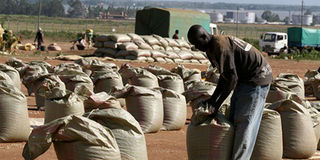Breaking News: At least 10 feared to have drowned in Makueni river
Providers of postharvest solutions honoured

A man packs dried maize in bags. Post-harvest solutions providers need to stimulate widespread adoption of improved grain storage to improving farmer access to effective loss prevention technologies. FILE PHOTO | NMG
What you need to know:
- The success in the sales of the technologies are further indications that Kenya farmers are willing to invest in proven technology to guard against post-harvest loss.
- The post-harvest tech competition dubbed AgResults Kenya on-farm storage pilot ran between May 2015 and October, 2018.
- Kello Harsama, administration secretary at the state department of crops, said that the country could become food secure by 2030 if post-harvest losses are addressed through such technologies.
Three agricultural solution companies have been awarded Sh400 million in recognition of their efforts in promoting improved grain storage solutions among small-holder farmers in the country.
The three companies –Bell Industries, A to Z Textile Mills, and Elite Innovations – are estimated to have sold 1,390,777 hermetic devices, creating 413,265 metric tons of improved storage space for smallholder farmers across the 14 counties.
The amount translates to about 4.6 million 90-Kgs bags of maize safely stored against post-harvest loss, or Sh11.5 billion (assuming a per bag market price of KES 2,500), according to Bill and Melinda Gate Foundation, the challenge sponsors.
The success in the sales of the technologies are further indications that Kenya farmers are willing to invest in proven technology to guard against post-harvest loss, experts noted.
The post-harvest tech competition dubbed AgResults Kenya on-farm storage pilot ran between May 2015 and October, 2018.
While the project targeted two regions namely, Rift Valley where 60 per cent of the country’s maize is produced and the Eastern region, which is the third largest maize-producing region but has experienced losses due to the larger grain borer pests, several regions across the country recorded positive uptake as well.
Kello Harsama, administration secretary at the state department of crops, said that the country could become food secure by 2030 if post-harvest losses are addressed through such technologies.
“Post-harvest solutions providers need to stimulate widespread adoption of improved grain storage to improving farmer access to effective loss prevention technologies,” Mr Harsama added.





